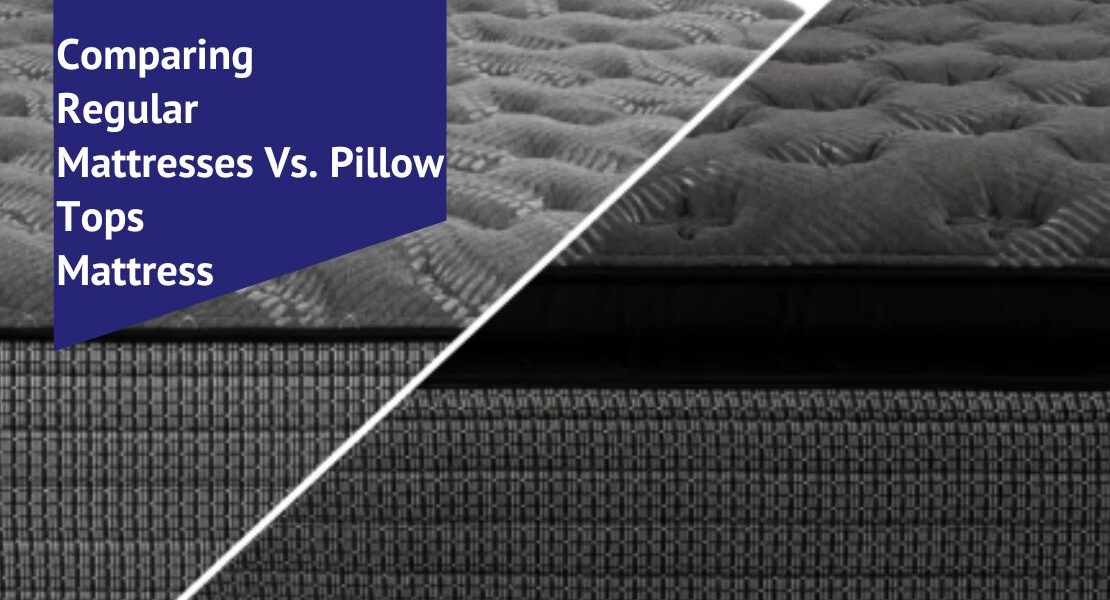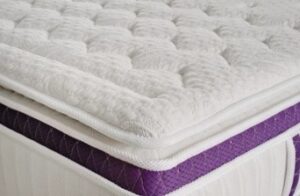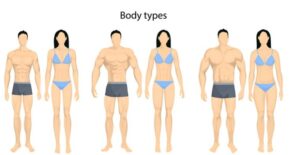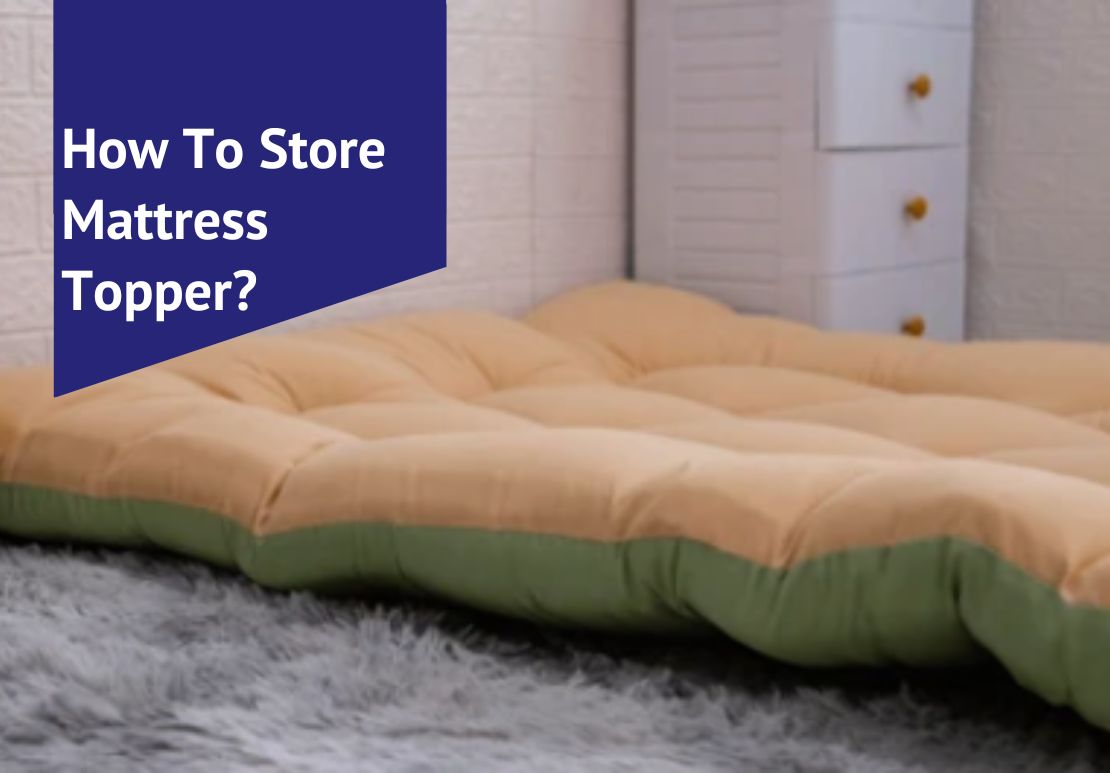Choosing the right mattress can impact your sleep quality and overall health, leaving many to wonder if a pillow top is worth considering over a regular mattress. Regular mattresses serve vast preferences and needs, with various types available on the market.
This article will delve into the comparison between conventional mattresses and their plush pillow-top counterparts to guide you toward making an informed decision for restful nights.
Discover which option cradles you into slumber best!
Table of Contents
Key Takeaways
- Regular mattresses come in many types, like innerspring and memory foam, offering a range of firmness levels without added cushioning.
- Pillow top mattresses have an extra layer for plush comfort but might not last as long because the padding can compress over time.
- While pillow tops provide luxurious softness ideal for side sleepers or those who enjoy a softer bed, they may not give the best support for back problems.
- Price-wise, pillow tops usually cost more than standard mattresses due to their additional comfort layer; this could impact budget decisions since they also have a shorter lifespan.
- Your sleeping position and body type play significant roles in choosing between regular and pillow-top mattresses—opt for what matches your need for support and personal preference in mattress feel.
Overview of Regular Mattresses
Regular mattresses come in various types, such as innerspring, foam, and hybrid. They offer different levels of firmness and support but may not have the added cushioning of a pillow-top mattress.
Types of Mattresses
Choosing the perfect mattress is key to a good night’s sleep. Homeowners have several options, each with unique features that cater to different preferences and needs.
- Innerspring Mattresses: These traditional mattresses are known for their firm support structure due to coils. They provide a bouncy feel and come in various firmness levels to suit back, stomach, or side sleepers.
- Memory Foam Mattresses: Made from viscoelastic foam, these beds contour closely to the body, offering excellent pressure relief. They absorb movement well, making them ideal for couples sharing a bed.
- Latex Mattresses: Natural latex mattresses are durable and eco-friendly. They offer a responsive feel with moderate cushioning and are typically cooler than memory foam.
- Hybrid Mattresses: Combining innerspring coils with foam or latex layers, hybrids provide support and comfort. They are versatile beds that blend the benefits of various mattress types.
- Adjustable Air Mattresses: Users can adjust their firmness by inflating or deflating air chambers within the mattress. This type offers customization for those with specific firmness preferences.
- Pillow Top Mattresses: Regular mattresses are enhanced with an extra comfort layer sewn on top for added plushness. They’re perfect for people desiring an extra cushioned sleeping experience.
Pros and Cons
Understanding the types of mattresses available is essential for homeowners investing in quality sleep. Now, let’s delve into the advantages and disadvantages of regular and pillow top mattresses to help guide your purchase decision.
| Pros of Regular Mattresses | Cons of Regular Mattresses | Pros of Pillow Top Mattresses | Cons of Pillow Top Mattresses |
| A diverse range of materials and firmness options cater to various preferences. | Some options may not provide sufficient cushioning for side sleepers. | Extra padding offers a plush sleeping surface that envelops the body. | It may retain more heat due to the additional cushioning layers. |
| Often more affordable compared to specialized mattresses. | It can be perceived as too firm for those seeking a softer sleep surface. | It is beneficial for those desiring a luxurious, soft bed feel. | It has a shorter lifespan and may develop indentations over time. |
| Generally, they have a longer lifespan and retain shape well. | It may not offer the same level of immediate comfort as pillow tops. | Provides additional support and cushioning in innerspring variations. | Typically more expensive than standard mattresses. |
| It is easier to rotate or flip to maintain mattress quality. | Some individuals may require additional mattress toppers for comfort. | Euro-top options offer a more seamless look with added cushioning. | It’s not ideal for those needing firmer back support. |
This table provides a clear comparison to assist homeowners in identifying the best mattress type that aligns with their needs, comfort preferences, and budget considerations.
Durability
Durability often defines the long-term value of a mattress, and both regular and pillow top options present distinctive longevity traits. Standard mattresses may boast robust materials like high-density foam or durable springs that retain their shape over the years.
They typically offer a firm sleeping surface that can withstand considerable wear and tear, maintaining support for sleepers night after night.
On the other hand, pillow top mattresses come with an extra layer of cushioning that adds to comfort but might compromise lifespan. This plush feel makes them vulnerable to quicker sagging as the additional padding tends to compress with time.
Homeowners seeking extended durability might hesitate here; despite initial softness and pressure relief advantages, these extra cushioned mattresses could require more frequent replacement than their firmer, non-pillow-topped counterparts.
Overview of Pillow Top Mattresses
Pillow-top mattresses are essentially regular mattresses combined with a topper, providing a plusher, more cushioned feel compared to standard mattresses. They have extra padding that provides more cushioning than regular mattresses, resulting in a softer and fluffier sleeping surface.
What is a Pillow Top?
A pillow top adds an extra comfort layer to a regular mattress, creating a plush, cushioned feel. It consists of extra padding that provides more cushioning than standard mattresses and envelops the body in softness.
This additional layer offers initial comfort but has a shorter shelf life than traditional mattresses. Innerspring mattresses also offer pillow top variations for those seeking support and cushioning.
However, it’s important to note that pillow tops may not be ideal for individuals with back problems or those who prefer firmer support.
Benefits – What Is The Point Of A Pillow Top Mattress?
Transitioning from the concept of a pillow top mattress, it’s essential to understand the benefits it offers. The main point of a pillow-top mattress is its luxurious comfort.
With extra padding and cushioning, these mattresses offer a plush feel that envelops your body when you lie down. This allows pressure relief and support, making them ideal for side sleepers or those who prefer a softer sleeping surface.
Additionally, pillow top mattresses are designed to enhance overall comfort with their extra cushioned layer, providing an indulgent sleeping experience.
What are the disadvantages of a pillow top mattress?
Pillow-top mattresses, while providing initial comfort, have a shorter shelf life than standard mattresses. The extra padding in pillow top mattresses can lead to body impressions and sagging over time, affecting the overall support and firmness of the mattress.
Additionally, some individuals with back problems or those who prefer firmer support may find that pillow top mattresses do not adequately meet their needs for proper spinal alignment and support.
The softness and plush feel of pillow top mattresses may also retain more heat than standard mattresses, which can be uncomfortable for those who tend to sleep hot. Furthermore, the added cushioning and material make pillow top mattresses generally heavier than regular mattresses, making them more challenging to move or rotate when necessary.
Key Differences Between Regular Mattresses and Pillow Tops
The construction, comfort and support, durability feature, and price are key factors that differentiate regular mattresses from pillow tops. If you want to learn more about these key differences and make an informed decision for your next mattress purchase, keep reading!
Construction
Pillow-top mattresses feature an additional comfort layer attached to the mattress surface. This extra layer provides a more cushioned feel than standard mattresses.
The construction of pillow tops involves additional padding, resulting in a softer, fluffier sleeping surface that offers enhanced pressure relief and support.
In contrast, regular mattresses typically do not include this extra comfort layer built into their construction. Instead, they offer a firm sleeping surface without the added plushness of a pillow top.
Comfort and Support
Pillow top mattresses provide a plush and cushioned feel that envelops the body, offering extra comfort and coziness. The additional padding in pillow tops creates a softer sleeping surface than regular mattresses, making them ideal for those who prefer a more luxurious and gentle support system.
However, it’s important to note that this softness may not be suitable for individuals with back problems or those requiring firmer spinal alignment support.
In contrast, standard mattresses offer firmer sleeping surfaces that strongly support the body. These mattresses are better suited for individuals looking for a more solid and stable foundation while they sleep.
Durability Feature
Regular mattresses are known for longevity, providing a durable sleeping surface that can withstand everyday use. Typically constructed with sturdy materials and solid support systems, these mattresses have a longer shelf life than pillow-top mattresses.
Innerspring beds, foam-based mattresses, and other non-pillow top options offer reliable durability without the added cushioning of pillow tops.
Pillow-top mattresses may not last as long as regular ones due to the nature of the extra padding they contain. The plush feel and softer comfort layer provide initial luxuriousness but can lead to quicker wear and tear.
Price
Pillow-top mattresses generally have a higher price tag than regular mattresses due to their additional padding and plush feel. The extra cushioning and luxurious comfort of pillow top mattresses often make them more expensive than standard mattresses.
Homeowners need to consider their budget and weigh the cost against the benefits of a pillow top mattress, especially considering that they have a shorter shelf life than traditional mattresses.
Additionally, Euro-top mattresses are similar to pillow tops but may offer additional cushioning and sometimes come at a slightly higher price point.
Choosing the Right Mattress for Your Needs
Consider your sleeping position, body type, and personal preferences when selecting a mattress. Side sleepers may benefit from a plush feel, while those needing more support should opt for firmer mattresses.
Sleeping Position
When choosing between regular mattresses and pillow tops, consider your sleeping position:
- Side Sleepers – A pillow-top mattress may provide better cushioning for pressure points if you sleep on your side.
- Back Sleepers – For back sleepers, both types can offer adequate support depending on personal preferences.
- Stomach Sleepers – Pillow top mattresses might be too soft for stomach sleepers who prefer a firmer surface for proper spinal alignment.
- Combination Sleepers – Those who switch positions during the night should consider a balance of comfort and support that suits various sleeping postures.
Body Type
Pillow-top mattresses are designed to cater to various body types, providing comfort and support for different individuals. Here are the factors to consider based on body type:
- Weight: Heavier individuals may benefit from a firmer mattress that offers adequate support, while lighter individuals might prefer a softer surface for added comfort.
- Pressure Points: Those with larger frames or curves may require extra cushioning to relieve pressure points and ensure proper spinal alignment during sleep.
- Back Support: People with specific back issues may need a mattress that provides firmness and contouring support to alleviate discomfort.
- Sleep Position: Body type plays a role in determining the most suitable mattress firmness for different sleep positions, such as side, back, or stomach sleeping.
- Mobility: Individuals with limited mobility or joint pain might require a mattress that minimizes motion transfer and allows for more effortless movement at night.
- Temperature Regulation: Certain body types may benefit from mattresses with enhanced breathability or cooling features to maintain comfortable sleeping temperatures.
- Long-Term Comfort: It’s essential to consider how body type may change over time and select a mattress that can accommodate potential changes in weight or physical conditions.
Personal Preferences
When selecting a mattress, personal preferences are crucial in determining the best fit for individual needs. Factors such as sleeping position, body type, and overall comfort level are essential considerations.
For instance, side sleepers may prefer a pillow top mattress’s plush feel and pressure-relieving qualities. At the same time, those seeking firmer support might lean towards traditional or Euro-top mattresses.
Furthermore, individuals with back problems may find standard top mattresses or firm options more suitable. Understanding one’s preferences is key to making an informed decision when choosing between regular mattresses and pillow tops.
Is a pillowtop mattress better than a regular mattress?
Pillow top mattresses offer a plusher, more cushioned feel compared to regular mattresses. They are softer, fluffier, and provide extra padding with a ‘bowed’ appearance at the top.
Pillow tops cater to those seeking super luxurious bedding comfort but have a shorter shelf life. However, if you prefer firmer support or have back problems, regular mattresses or Euro-top variations might suit your needs.
Ultimately, choosing between pillow tops and regular mattresses depends on personal preferences for firmness and comfort level of sleeping surface.
Innerspring beds also come in pillow top variations that provide additional support and cushioning. At the same time, plush mattresses can offer an even softer feel than pillow tops, which may better suit individual preferences based on specific needs such as body type or favored sleep position.
Conclusion
In conclusion, one must consider personal preferences and sleeping needs when comparing regular mattresses and pillow tops. Regular mattresses offer firm support and durability, making them suitable for individuals with back problems or who prefer a firmer sleeping surface.
On the other hand, pillow top mattresses provide extra cushioning and a plush feel, ideal for those seeking added comfort and pressure relief. Understanding the key differences in construction, comfort level, durability features, and price can help homeowners choose the right mattress that aligns with their specific requirements.
FAQs – Frequently Asked Questions
What is the difference between a regular mattress and a pillow top?
A regular mattress has a uniform surface, while a pillow top features an added layer of padding on the surface for extra comfort.
Are pillow tops more comfortable than regular mattresses?
Pillow tops are generally perceived as more comfortable due to their additional cushioning, providing a softer feel than traditional mattresses.
Do pillow top mattresses require special sheets or bedding?
Due to the added thickness of the pillow top layer, deep-pocket fitted sheets are often recommended to accommodate the mattress depth adequately.
How do regular mattresses and pillow tops differ in support?
Regular mattresses typically offer firmer support, while pillow tops provide softer cushioning on top of the underlying support core.
Are there any drawbacks to choosing a pillow top over a regular mattress?
One potential drawback is that the softness of some pillow tops may lead to quicker compression and indentation over time compared to firmer traditional mattresses.
Do pillow top mattresses wear out faster?
Pillow-top mattresses may wear out faster due to the additional cushioning on top, which can compress and lose its shape over time. The extra layer of padding may also make the mattress more prone to indentations and sagging. Regular flipping and rotating can help prolong a pillow-top mattress's lifespan. However, remember to follow the manufacturer’s instructions.

 Image source - bestmatt
Image source - bestmatt 






